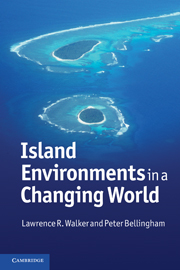Book contents
- Frontmatter
- Contents
- Preface
- Photo credits
- 1 Introduction to island environments and cultures
- 2 The physical setting
- 3 Natural disturbances on islands
- 4 The plants and animals of islands
- 5 Human dispersal, colonization, and early environmental impacts
- 6 Intensifying human impacts on islands
- 7 Islands in the modern world, 1950–2000
- 8 The future of island ecosystems: remoteness lost
- Glossary
- Index
- Plate section
Preface
Published online by Cambridge University Press: 05 June 2012
- Frontmatter
- Contents
- Preface
- Photo credits
- 1 Introduction to island environments and cultures
- 2 The physical setting
- 3 Natural disturbances on islands
- 4 The plants and animals of islands
- 5 Human dispersal, colonization, and early environmental impacts
- 6 Intensifying human impacts on islands
- 7 Islands in the modern world, 1950–2000
- 8 The future of island ecosystems: remoteness lost
- Glossary
- Index
- Plate section
Summary
What makes islands so special to many of us? Is it their remoteness and the special effort we make to get to them? Is it their sharp land–water boundaries decorated by pretty beaches or dramatic, rocky shorelines? Is it their volcanoes or coral reefs? Is it their unusual and often rare plants and animals? Or perhaps it is their exotic cultures and unique languages? Whatever the attraction, tens of millions of people visit islands each year. As scientists, we too enjoy the scenic and cultural attractions and have been drawn to study the fascinating island plants and the animals that interact with them. However, we recognize that the massive popularity of islands and their burgeoning populations are changing island environments and that islands are particularly vulnerable to global climate changes, such as increases in air and water temperatures, sea level rise, and ocean acidification. We wrote this book to examine how humans have interacted over time with island environments from their earliest colonization until the present.
Our findings suggest that because of human colonization and development, island environments have lost the isolation that protected them as evolutionary experiments. With finite habitats, limited resources, and little protection from humans and the organisms humans bring with them, island plants and animals are vulnerable to extinction. Further, widespread introductions of non-native species have resulted in a global homogenization of plants and animals. In turn, populations of humans on islands are vulnerable because they rely on healthy environments for their well-being.
- Type
- Chapter
- Information
- Island Environments in a Changing World , pp. xi - xiiiPublisher: Cambridge University PressPrint publication year: 2011

